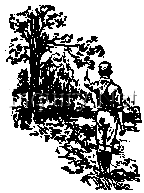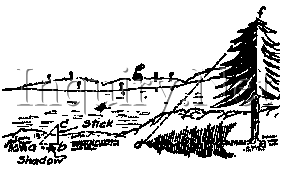Learning to Judge Distance
As a means of checking your estimates, learn the exact length of your pace. If fairly tall, learn to pace an exact yard, heel to heel. On a quiet road, in a field, or out on the prairie, begin judging short distances to various objects, then pacing to check your "guess." Gradually increase the distances. Do this in competition with several other Scouts and you'll find it an interesting game. Remember that the eye measures distance as in an "air line," from eye to object, and does not allow for irregularities of the ground. In other words, ground distance may be greater than visual distance.

Personal Measurements
As an aid in making short measurements you should know a number of your personal measurements. Your known hand-span will often be particularly useful. If fully developed your measurements will be close to this:
| Breadth of thumb, and nail joint of forefinger = 1 inch (2.54 centimeters). | |
| Span of the thumb and forefinger = 6.5" (or 17 centimeters). | |
| Span of thumb and any other finger = 8.5" (or 21.6 centimeters). | |
| Wrist to elbow = 10" (or 25 centimeters). | |
| Elbow to tip of forefinger = 17" (or 43 centimeters). | |
| Your reach, arms out-stretched, will nearly equal your height. |
Some Further Hints
| At 1/2 mile or approximately 880 yards (or 800 meters) a man looks a post. | |
| At 770 yards (or 700 meters) the head is not yet visible. | |
| At 660 yards (or 600 meters) the head is visible as a dot. | |
| At 550 yards (or 500 meters) the shoulders appear bottle shaped. | |
| At 1/4 mile, or approximately 440 yards (or 400 meters) movements of the legs can be seen. | |
| At 330 yards (or 300 meters) the face can be seen. | |
| At 220 yards (or 200 meters) buttons and details of clothing are recognizable. | |
| At 110 yards (or 100 meters) eyes and mouth can be seen clearly. |
To estimate greater distances, judge the farthest probable distance, then the nearest possible, and "split the difference."
Judging Height
With practice you will be able to estimate height up to 1,000 yards or meters.

Pencil Method
Pencil Method: A simple method for measuring the height of trees and ordinary buildings is the Pencil Method. Standing some 25 yards or meters from the tree, with a pencil or stick held upright in the fully extended hand, first move the thumb up the stick until the exposed length covers, to your eye, the lower two yards or meters of the tree (the height of a man). Now move hand and pencil up in two yard or meter jumps till the top is reached. Multiply the jumps by six and add any odd yards or meters left at the top. To get the height of a building a rapid method is to calculate the height of a story, and multiply by the number of stories.

Height by Shadow
Shadow Method: You need your staff, notched in feet and inches (or meters and centimeters); or a straight stick of known length (measured by the spread of your fingers). Proceed thus (see above illustration): Stand the staff (b c) upright in the sun and measure the length of its shadow (a b). Measure the length of the shadow of the tree. Multiply by the length of the staff. Divide by the length of the staff shadow. The result is the height of the tree.
For example, say the length of the tree's shadow is 40 feet or meters, the staff's shadow ten feet or meters and the staff is the normal length of 1.73 feet or meters, the formula will be as follows:
40 x 1.73 = 69.2 divided by 10 = 6.92

"Inch to the Foot Method" or
"One in Twelve"
Inch to Foot: Here you start from the base of the object which you are measuring, mark off eleven units of any length, say eleven staff-lengths, here set up a Scout staff with a companion to hold it. Measure off one more one unit beyond the upright staff and there, getting your eye as close to the ground as possible, sight the top of the object. Where that sighting line cuts the staff have your companion make a mark on the upright staff, then measure the number of INCHES from that mark to the ground. This will equal the height of the object in FEET.

Estimating the Width of a River.
The Width of a River: Pick out a point A (illustration) just opposite a tree, X (or other prominent object) on the other side of the river, and drive a stake in the ground. At right angles to the imaginary line across the river make a base line AB, any convenient length, say 40 feet or meters, here place a stone or push a stick into the ground. Continue along in the same direction for half the first distance you measured, to point C; CB will be 20 feet or meters. At point C turn at right angles and walk inland until you bring your marker and distant tree in line, stop at this point, D. Now measure the line CD. This will give you half the distance from A to X. Double that and there's your answer.
Judging Distance by Sound
Distance can sometimes be judged by sight and sound. If you see a gun fired, for instance, and count the seconds between the flash and report, you can tell how far the sound has come, if you remember that sound travels at 365 yards a second.
During a thunder and lightning storm you may be able to quiet nervous people by pointing out to them the time between the flash of lightning and the roll, or crash of a bolt -this proving that the bolt in reality struck several miles away.